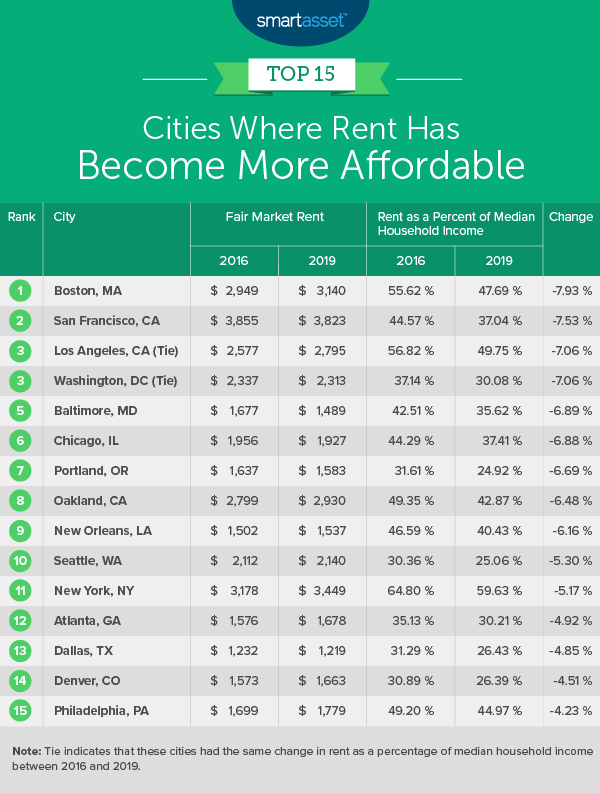Affordability issues generally affect renters more than homeowners. More than 40% of renters pay more than a third of their household income on rent compared to just 24% of homeowners on their mortgage, according to a February 2020 survey by Freddie Mac. But depending on where they live, renters can lower the burden of their housing costs. That’s why SmartAsset crunched the numbers to identify cities in the U.S. where rent has decreased the most relative to income.
Specifically, we compared rent prices from 2016 and 2019 to median household incomes over the same period. We additionally examined how rent prices have changed during 2020, amid the COVID-19 crisis. For details on our data sources and how we put all the information together to create our final rankings, check out the Data and Methodology section below.
This is SmartAsset’s second annual study on changes in rent affordability. Check out the 2019 version here.
Key Findings
- Boston moves into the top spot. Last year, Boston, Massachusetts ranked third in our list of cities where rent is becoming more affordable. This year, it moved up to first, outranking both San Francisco and Oakland, California. Between 2016 and 2019, rent as a percentage of income fell by almost 8%.
- Coastal cities dominate the top of our list. The top 11 cities where rent has become more affordable are located on a coast. They consist of five on the West Coast (San Francisco, Los Angeles and Oakland, California as well as Portland, Oregon and Seattle, Washington), four on the East Coast (Boston, Massachusetts; Washington, D.C., Baltimore, Maryland and New York, New York), one on the Gulf Coast (New Orleans, Louisiana) and one on the coast of Lake Michigan (Chicago, Illinois). Across those 11 cities, average fair market rent rose by an average of less than 2% between 2016 and 2019, while median household income rose by more than 19% on average.
Top Five Cities Where Rent Has Become More Affordable (2016 – 2019)
1. Boston, MA
Households in Boston, Massachusetts are allocating smaller portions of their paychecks to rent. Though average market rent did not fall over the course of the past three years, incomes rose significantly, causing the average percentage of household income spent on rent to decrease. In 2016, the average fair market rent was $2,949, and median household income was $63,621. In 2019, rent was $3,140, and median income was $79,018. In percentage terms, rent rose by just under 7%, while incomes rose by more than 24% on average.
2. San Francisco, CA
Though rent in San Francisco, California is high relative to many other cities, data from Rent Jungle shows that it has remained flat over the past few years. The average fair market rent was $3,855 in 2016 and $3,823 in 2019. Incomes, by contrast, are on the rise. Between 2016 and 2019, the median household income in San Francisco rose by more than 19%, from about $103,800 to almost $123,900. As result, households are spending, on average, 7.53% less on rent in 2019 than they were in 2016.
3. Los Angeles, CA (Tie)
In Los Angeles, California, the average market rent increased by about $200 between 2016 and 2019, while the median household income increased by almost $13,000. With those changes, households are spending about 7% less of their income on rent.
Notably, despite increasing rent affordability, Los Angeles residents are still spending a lot on rent. In 2019, rent as a percentage of income was 49.75%, the second-highest in our study, behind only that of New York City.
3. Washington, DC (Tie)
The nation’s capital ties with Los Angeles for the No. 3 city where rent has become more affordable. Using Rent Jungle and Census Bureau data, we found that the average household spent about 37% of its gross income on rent in 2016, relative to only 30% in 2019. This large change was caused by primarily by increasing incomes in the city. Between 2016 and 2019, the median household income of residents rose by more than 22%, from roughly $75,500 to almost $92,300.
5. Baltimore, MD
Incomes in Baltimore, Maryland are the lowest of any city in our top five. In 2019, the median household income of Baltimore residents was about $50,200. Between 2016 and 2019, average market rent in the city fell by about $200, while the median household income rose by more than $2,800. With those changes, rent as a percentage of income decreased from almost 43% in 2016 to roughly 36% in 2019.

How the Rental Market Has Changed During COVID-19 (January – September 2020)
We looked at rent affordability through 2019 in the above section because 2020 median household income figures are not yet available. However, we can still see changes in the rental market and subsequent prices for 2020, through the third quarter of the year. Generally, housing markets for renters have been more deeply affected than markets for homeowners during the pandemic. While some families have left big cities to buy more spacious homes in the suburbs, Zillow’s 2020 Urban-Suburban Market Report research shows that suburban housing markets have not strengthened at rates disproportionate to urban ones. The same is not true, however, for rental markets. Zillow found that though rental prices have generally dropped in both urban and suburban areas during the COVID-19 pandemic, the decline has been larger in urban ZIP codes.
This decline has been particularly significant in some of the largest and most populated urban areas. Rent Jungle data shows that average rent prices fell by more than 5% from January to September 2020 in six cities – San Francisco, California; Detroit, Michigan; Boston, Massachusetts; San Jose, California; New York, New York and Austin, Texas – all of which have populations exceeding 670,000. Of those, San Francisco leads for its drop in average fair market rent. Rent Jungle data shows that the average fair market rent in the city fell by almost 17%, from almost $3,800 in January 2020 to about $3,100 in September 2020. Following San Francisco, the biggest gross change in rent occurred in Boston. In January 2020, Rent Jungle reported an average fair market rent of almost $3,200 relative to less than $2,900 in September 2020.
Data and Methodology
To complete our analyses for both sections of this report, we looked at data for 50 of the largest U.S. cities. Specifically, we compared:
- 2016 rent as a percentage of household income. This is average annual rent divided by median household income. Data comes from rentjungle.com and the Census Bureau’s 1-year American Community Survey.
- 2019 rent as a percentage of household income. This is average annual rent divided by median household income. Data comes from rentjungle.com and the Census Bureau’s 1-year American Community Survey.
To create the final rankings of cities where rent has become more affordable, we subtracted the 2016 rent as a percentage of household income from the 2019 rent as a percentage of household income. The cities with the largest negative difference – i.e. where relative cost decreased the most – ranked as our top cities where rent is becoming more affordable.
When looking at the rent market in 2020, we compared Rent Jungle data on the average market rent in January 2020 to the average in September 2020. We found the percentage change over that eight-month time period for all 50 of the cities we looked at.
Financial Tips for Renters
- Invest your savings early. If you’re living in a city where you’ve experienced robust income growth and minute upticks in your rental costs, you might consider putting those savings to work in a retirement account. After all, achieving a secure retirement requires early preparation. By planning and saving early you can take advantage of compound interest. Take a look at our investment calculator to see how your investment can grow over time.
- Rent or buy? Understand whether continuing to rent is the right choice for you using SmartAsset’s rent vs. buy calculator. No matter what your homeownership status, it might be useful to learn about the ways that the recent Coronavirus Aid, Relief and Economic Stablility (CARES) Act passed by the government protects homeowners and renters.
- Consulting an expert could save you time and money in the long run. If you are looking for guidance on how to put your rental savings to good use, it might be helpful to speak with an expert advisor. Finding the right financial advisor doesn’t have to be hard. SmartAsset’s free tool matches you with financial advisors in your area in five minutes. If you’re ready to be matched with local advisors that will help you achieve your financial goals, get started now.
Questions about our study? Contact us at press@smartasset.com.
Photo credit: ©iStock.com/fizkes
